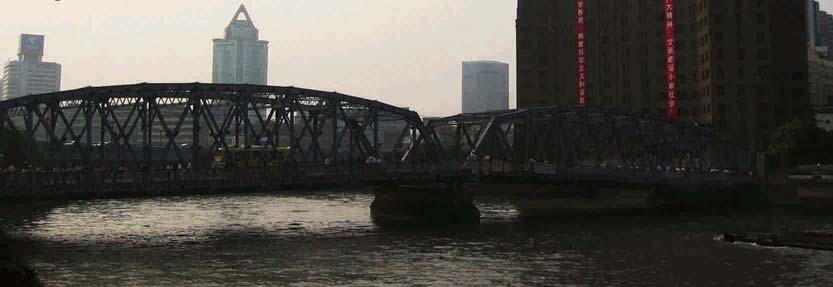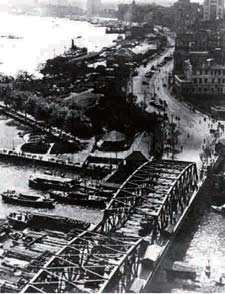Waibaidu Bridge (Garden Bridge) is one of the landmarks of old Shanghai. Located in the downstream estuary of Suzhou Creek near the Huangpu River, it is an important bridge connecting Shanghai’s urban districts with northern and southern Shanghai. The bridge is completely made of steel, 52.16m long and 18.3m wide.
Waibaidu Bridge was first a wooden bridge built in 1856, financed by the English “Suzhou Creek Bridge Corporation” (the first company in China focusing mainly on bridge construction). During the reign of Emperor Guangxu, the wooden bridge was restored several times. When it could no longer meet the requirements of the transportation development, the Shanghai Municipal Council decided to replace it with a steel bridge. The new bridge was completed in 1907. It is what we know today as Waibaidu Bridge, the first all-steel bridge in China. The Shanghai Municipal Council was in charge of the construction; the steel was imported from England and the bridge’s design was done by British engineers and technicians.
Because of comprehensive traffic reformation and the construction of a Bund underpass, the 100-year-old bridge was temporarily removed. In April, 2008, it was dismantled from its site and conveyed to the Shanghai dockyard for renovations. The plan obtained a written approval from the State Cultural Relic Bureau before it was enacted. With the Bureau’s affirmation, the bridge’s body above the lowest water level was kept intact. This maintenance plan was a bold but also scientific one. It raised the safety coefficient in preserving the historical relic during the underpass construction, and at the same time enabled Shanghai citizens to use the bridge for another fifty years. In the future, ultrasonic detections will be conducted every ten years to ensure the safety of the bridge. In addition, to preserve the historical appearance of the old bridge, symbolic elements such as rivets and paint, the department was responsible for the renovation project specially to invite professionals from abroad and changed over 60 thousand rivets. Besides, the 3.6m wide pavement on both sides of the bridge w still be paved with boards, to maintain the same look Waibaidu Bridge had in 1907.
After 10 months of removal and overhaul, Waibaidu Bridge returned to its home position by barge on February 25, 2009. Once again it spans the estuary of Suzhou Creek, but this time, with a “new life” in it.


|




